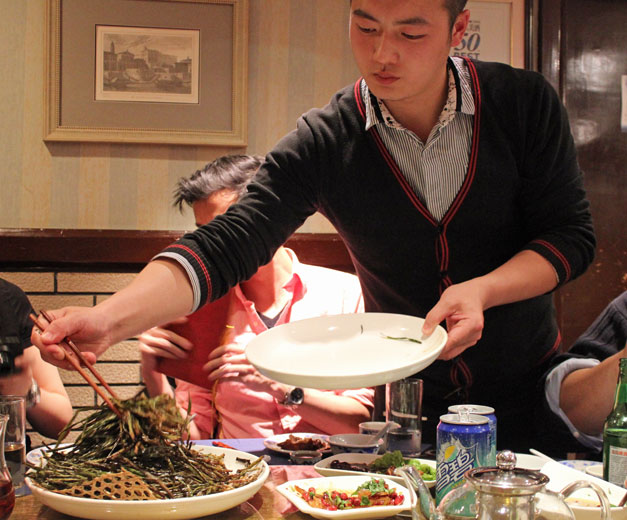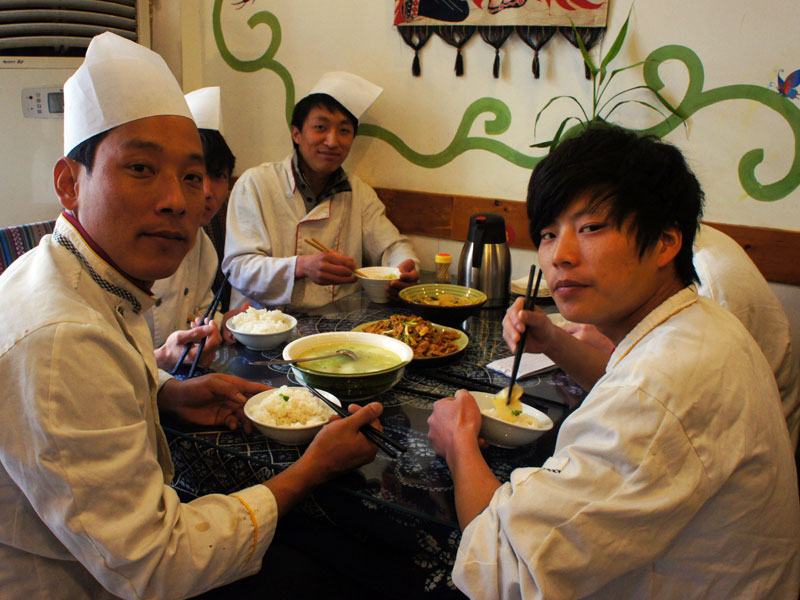We can't find the internet
Attempting to reconnect
Something went wrong!
Hang in there while we get back on track


Shanghai
Shanghai's culinary record
In 2017, Shanghai’s longest-running open-air market at Tangjiawan Lu, which had provided the neighborhood with fresh produce, fish and seasonal foodstuffs for almost 115 years, shuttered its doors. The market and much of the area around the Laoximen metro station were some of the last historical (albeit run-down) structures in an otherwise central area full of expensive new residences. Construction has already begun on the entire city block’s worth of high-rises being built in its place, and the surrounding blocks – like many of Shanghai’s backstreets – are on notice, as the wrecking balls and construction crews continue to reshape the urban landscape at an incredibly fast rate.
Get the Full Story →discover the city, street by street, bite by bite
Explore Shanghai
Shanghai
Ben Lai & Ben Zhen: The Other Sichuan
Sichuan cuisine is famous for its mouth-numbing, spicy flavors, but what many people don’t know is that the provincial cuisine is subdivided into several specialty subregional cuisines. One of our favorites is Xiaohe Sichuan cuisine, which hails from the cities of Zigong, Luzhou and Yibin in the province’s southern region. Originally famous for its salt mining, the Xiaohe (which means “small river”) region is now perhaps best known for the Zigong Dinosaur Museum, a monumental museum built over a dig site that’s had an incredible number of dinosaur finds. But the local cuisine – renowned for being spicy and creative – is worth exploring.
Read moreShanghai
Fu Chun Xiao Long: Shanghai Snack Attack
We’ve raved about the Shanghai-style soup dumplings at Fu Chun for years now, but let us let you in on a secret: There’s more to this tiny hole-in-the-wall than its xiaolongbao. Since 1959, the restaurant has been serving up benbang dishes, but little has changed on the menu or in the kitchen. A Huaiyang snack shop, Fu Chun admittedly skews Shanghainese in its regional flavor profile, which means extra sugar and a lot of pork. Try the traditional deep-fried pork cutlet (炸猪排, zhà zhūpái). Pounded thin before hitting the deep fryer, these fatty flanks are served sliced with a side of black rice vinegar – a dip helps cut the grease.
Read moreShanghai
Yang Yang’s Dumplings: The Other Yang
Search online for Shanghai’s best fried dumplings, and you’ll come up with hundreds of results extolling Yang’s Fried Dumplings. Though it was once just a humble shop sandwiched between the Bund and People’s Square, the online renown and ensuing crowds have propelled the brand into chain-store ubiquity, populating new malls and shopping streets with fervor. In essence, they’ve become the Starbucks of dumplings; you’re going to get a relatively consistent product, but come on, you can do so much better! Enter Yang Yang’s.
Read moreShanghai
Wenxiang Manchurian Dumpling House: Fishy Business
When it comes to Chinese dumplings, fish is likely not the first filling that springs to mind. But that’s probably because you haven’t had the chance to try Liaoning province’s specialty: boiled mackerel dumplings. Dishes from Liaoning, which is located northeast of Beijing, fall under the regional umbrella of Dongbei (northeastern) cuisine. The staple grain up north is wheat and corn, with noodles, steamed breads and dumpling wrappers supplying most of the carbs in the local diet. The area wraps around the coastline of the Yellow Sea, bringing fresh seafood to the table, and its proximity to the Korean Peninsula means an abundance of pickled veggies.
Read moreShanghai
Taiwanese Pork Rice: Balancing Act
Shanghai doesn’t fit the traditional (if often false) narrative that urban spaces consist of “good” neighborhoods and “bad” neighborhoods. Crime is not a major concern for most residents in the city, and truly derelict areas are few and far between. However, the varying levels of development and infrastructure create different zones that deeply impact residents’ lifestyles in ways that are more extreme than in other more developed countries. On a recent weekend road trip to Moganshan, a mountainous oasis of bamboo forests just a few hours from Shanghai, the starkness of the city’s “development zones” came to light as we made our way home to the tree-lined streets of the former French Concession
Read moreShanghai
A Da Cong You Bing: New Home, Same Cult Pancake
In September of last year, Shanghai eaters were shocked when Mr. Wu shuttered A Da Cong You Bing, the city’s best scallion pancake shop. The only explanation for the abrupt closure was a worn sign on the door that read: “My family has a problem. The stall will be closed for a few days.” But this wasn’t the whole truth. Some attributed the shutdown to the fact that the stall was featured on the BBC program Rick Stein’s Taste of Shanghai, claiming that it had drawn too much attention to the unlicensed vendor and the government had taken note.
Read moreShanghai
Liu Tang Men: Chengdu Noodles, Done Right
In the past year, we’ve seen more new noodle houses hawking spicy Chengdu and Chongqing style noodles than we can count on two hands. Very few of the Shanghai-based noodle houses do the fly restaurants of Chengdu justice. Some dish out bowls of insipid strands that barely register on the Scoville scale, while others go for that unbalanced, burn-your-face-off flare that means the chef has likely never been to Sichuan, much less studied the careful art of the region’s balanced cooking. Liu Dao Men is among the exceptions, carefully walking the tightrope of spicy yet tasty, with its menu of Chengdu noodle classics.
Read moreShanghai
Old Jesse: The Inside Track to a Guidebook Favorite
Ask a Shanghainese person for the best běnbāng, or local, restaurant in town, and you’ll probably be pointed toward Old Jesse. The doyenne of haipai cuisine, this ramshackle restaurant is the darling of the guidebook industry, with mentions in publications from Travel + Leisure to Lonely Planet, but that doesn’t mean that it’s foreigner-friendly. In fact, when LP first published their listing back in 2008, Old Jesse stopped taking reservations in English for some time, just to spite the hordes of tourists vying for a seat in their tiny former French Concession establishment. Even now, the lingua franca in the packed dining room is Shanghainese, and it’s still not uncommon for a laowai’s reservations to disappear if he or she is just a few minutes late, or for foreigners to have to watch hungrily as the dishes they ordered come out to tables manned by locals first, even though said locals were seated long after them.
Read moreShanghai
Wei Xiang Zhai: One-Dish Wonder
Sometimes a word in Chinese so perfectly captures a mood or feeling that the English approximation seems woefully inadequate. To take one example, the Chinese combine “hot” (热) and “noise” (闹) to describe the loud and lively nature of local hotspots, but in English, the best we can do is “bustling.” To experience what China’s “hot noise” is really all about, head to Wei Xiang Zhai. Not for the claustrophobic or timid, this wildly popular noodle house demands that you elbow your way to a table for your chance to slurp down a bowl of the city’s best sesame paste noodles (麻酱面, májiàng miàn).
Read moreDaily Dispatches from the Frontlines of Shanghai
Latest Stories: Shanghai
Visual Dispatches from the Frontlines of Local Eating
Shanghai Videos

The noodleman at Shanghai's Henan Lamian

Shanghai Jianbing

Fava season in Shanghai's markets

A stroll through Shanghai's Tangjiawan Lu "wet market"

The Noodle "Breakdancer" at Shanghai's Hai Di Lao
Culinary Backstreets® Envoys, Always Searching for the Next Hidden Gem
Meet Our Shanghai Team

Jamie
Shanghai Correspondent

Kyle
Shanghai Correspondent






























